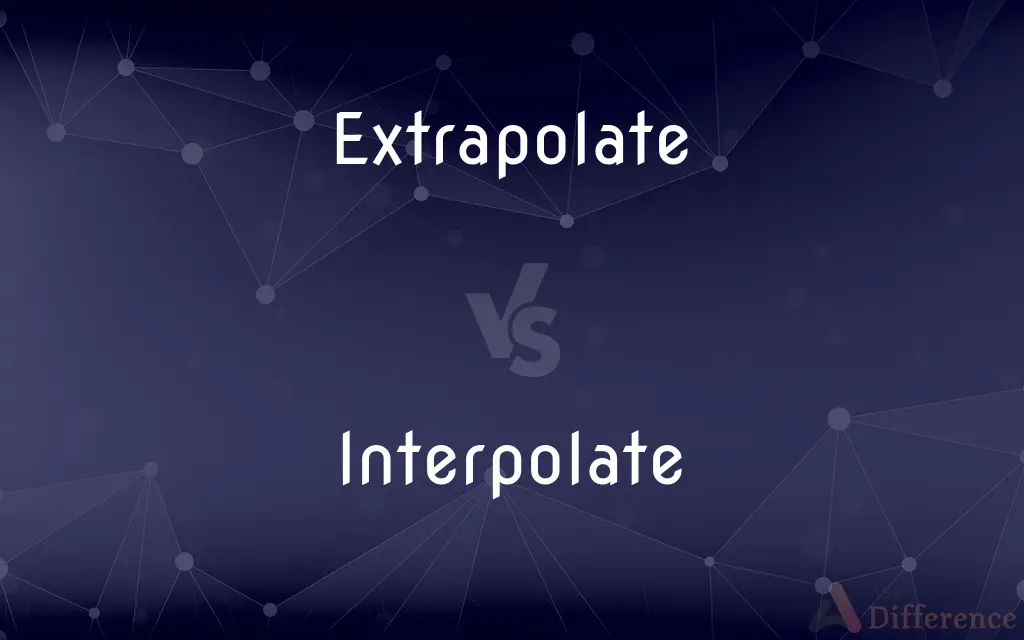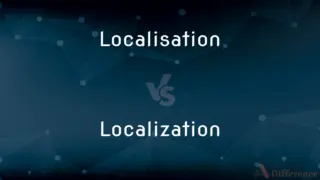Extrapolate vs. Interpolate — What's the Difference?
Edited by Tayyaba Rehman — By Urooj Arif — Updated on April 4, 2024
Extrapolation estimates beyond the known range using existing data trends, while interpolation finds values within the known data range.

Difference Between Extrapolate and Interpolate
Table of Contents
ADVERTISEMENT
Key Differences
Extrapolation involves predicting values by extending a known set of data or trends into the future or outside of the original observation range. It is used when the goal is to predict beyond the existing data points. Whereas, interpolation is the method of estimating values within the limits of a dataset. It helps in finding missing or intermediate values by using the data's existing structure.
Extrapolation relies on the assumption that the patterns observed in the data will continue beyond the existing data points. This can lead to higher uncertainty in predictions, as it ventures into the unknown. On the other hand, interpolation typically offers more reliable estimates because it works within the bounds of the known data, assuming the data follows a consistent pattern throughout.
One common application of extrapolation is in forecasting future events or trends, such as population growth or financial market trends. Whereas interpolation is often used in mathematical modeling and data analysis to estimate missing data points or to smooth data.
The mathematical models used for extrapolation can vary widely, from linear models that assume a straight-line trend to more complex models that account for potential shifts or changes in patterns over time. In contrast, interpolation methods, such as linear interpolation or spline interpolation, are generally simpler, as they focus on creating a smooth curve or line that fits between known data points.
Extrapolation is particularly useful in scenarios where data is limited but an understanding of future trends is necessary. It enables decision-makers to plan for various future scenarios. Interpolation, by contrast, is invaluable in enhancing the detail and accuracy of datasets, allowing for more precise analysis and understanding of existing data.
ADVERTISEMENT
Comparison Chart
Definition
Predicting values outside the range of known data points.
Estimating values within the range of known data points.
Purpose
To forecast or predict future trends.
To fill in missing data or smooth existing data.
Data Range
Beyond the existing data.
Within the existing data.
Reliability
Less reliable due to predictions outside known data.
More reliable, as it's based on existing data patterns.
Common Applications
Future trend analysis, risk management.
Data analysis, mathematical modeling, data smoothing.
Compare with Definitions
Extrapolate
Making inferences about future events from current information.
Extrapolating economic indicators to forecast economic growth.
Interpolate
Adjusting data to provide more accurate information.
Interpolating satellite data to improve map accuracy.
Extrapolate
Estimating a value outside the known series by projecting existing trends.
Using demographic trends to extrapolate population growth.
Interpolate
Estimating the value of a function between two known values.
Interpolating to find the temperature at midday from morning and evening readings.
Extrapolate
Forecasting unknown situations based on known data.
Extrapolating climate data to predict future weather conditions.
Interpolate
Using known data points to estimate intermediate values.
Interpolating to determine the stock price at noon between the opening and closing prices.
Extrapolate
Predicting the future value of a variable based on its past trends.
Extrapolating from past sales data to predict next year's revenue.
Interpolate
Filling in missing data points within a dataset.
Using interpolation to estimate missing heart rate data in a time series.
Extrapolate
Extending a graph or curve beyond known data points.
Extrapolating a curve to estimate values not measured in the experiment.
Interpolate
Creating a smooth curve that passes through known data points.
Interpolating a curve in a graph to show a trend.
Extrapolate
To infer or estimate by extending or projecting known information.
Interpolate
Insert (something of a different nature) into something else
Illustrations were interpolated in the text
Extrapolate
(Mathematics) To estimate (a value of a variable outside a known range) from values within a known range by assuming that the estimated value follows logically from the known values.
Interpolate
Interject (a remark) in a conversation
‘I dare say,’ interpolated her employer
Extrapolate
To engage in the process of extrapolating.
Interpolate
To insert or introduce between other elements or parts.
Extrapolate
(transitive) To infer by extending known information.
Interpolate
To insert (material) into a text.
Extrapolate
To estimate the value of a variable outside a known range from values within that range by assuming that the estimated value follows logically from the known ones
Interpolate
To insert into a conversation.
Extrapolate
Draw from specific cases for more general cases
Interpolate
To change or falsify (a text) by introducing new or incorrect material.
Extrapolate
Estimate the value of
Interpolate
To estimate a value of (a function or series) between two known values.
Extrapolate
Gain knowledge of (an area not known or experienced) by extrapolating
Interpolate
To create a continuous function that incorporates (a finite set of data), such as creating a curve that passes through a fixed set of points or a surface through a fixed set of curves.
Interpolate
To introduce estimated values of (pixel data) into a pixel array to improve the quality of an enlarged digital image.
Interpolate
To make insertions or additions.
Interpolate
To introduce (something) between other things; especially to insert (possibly spurious) words into a text.
In verse 74, the second line is clearly interpolated, probably by some unknown medieval scribe
When interpolating an explanatory gloss, please enclose it in square brackets to make clear that it is interpolated.
Interpolate
(mathematics) To estimate the value of a function between two tabulated points.
Interpolate
(computing) During the course of processing some data, and in response to a directive in that data, to fetch data from a different source and process it in-line along with the original data.
Interpolate
To renew; to carry on with intermission.
Motion . . . partly continued and unintermitted, . . . partly interpolated and interrupted.
Interpolate
To alter or corrupt by the insertion of new or foreign matter; especially, to change, as a book or text, by the insertion of matter that is new, or foreign to the purpose of the author.
How strangely Ignatius is mangled and interpolated, you may see by the vast difference of all copies and editions.
The Athenians were put in possession of Salamis by another law, which was cited by Solon, or, as some think, interpolated by him for that purpose.
Interpolate
To fill up intermediate terms of, as of a series, according to the law of the series; to introduce, as a number or quantity, in a partial series, according to the law of that part of the series; to estimate a value at a point intermediate between points of knwon value. Compare extrapolate.
Interpolate
Estimate the value of
Interpolate
Insert words into texts, often falsifying it thereby
Common Curiosities
How do extrapolation and interpolation differ in purpose?
Extrapolation is used for predicting future or unknown values, while interpolation is used to estimate missing or intermediate values within known data.
Do extrapolation and interpolation require complex mathematical models?
Extrapolation may require complex models to predict future trends accurately, while interpolation often uses simpler models since it deals with existing data.
Is interpolation more accurate than extrapolation?
Generally, interpolation is considered more accurate than extrapolation because it operates within the known data range.
What are common applications of extrapolation?
Extrapolation is commonly used in forecasting, such as predicting population growth or market trends.
What are common applications of interpolation?
Interpolation is widely used in data analysis and mathematical modeling to estimate missing data and smooth data.
Is extrapolation only applicable to linear trends?
No, extrapolation can apply to both linear and nonlinear trends, though the method and reliability may vary.
What is extrapolation?
Extrapolation is the process of estimating values beyond the existing data range based on observed trends.
What is interpolation?
Interpolation is the method of estimating values within the bounds of a dataset based on its existing structure.
Can extrapolation be used to predict any type of data?
While it can be applied to various data types, the reliability of extrapolation depends on the consistency of the data's trends and patterns.
Why is extrapolation considered less reliable?
Because it makes predictions based on extending trends beyond the known data, which introduces more uncertainty.
How do the assumptions made in extrapolation and interpolation differ?
Extrapolation assumes that current trends will continue outside the observed range, whereas interpolation assumes data follows a consistent pattern within the range.
Are there different methods of interpolation?
Yes, common methods include linear interpolation, spline interpolation, and polynomial interpolation, each suited to different types of data.
Can interpolation be used to smooth data?
Yes, interpolation is often used to smooth data by creating a curve or line that fits snugly between known data points.
Why is understanding both extrapolation and interpolation important?
Understanding both is crucial for accurate data analysis, forecasting, and making informed decisions based on data trends.
Can interpolation help in improving data accuracy?
Yes, by estimating missing values or adjusting data, interpolation can enhance the accuracy and detail of datasets.
Share Your Discovery

Previous Comparison
Warm vs. Sunny
Next Comparison
Localisation vs. LocalizationAuthor Spotlight
Written by
Urooj ArifUrooj is a skilled content writer at Ask Difference, known for her exceptional ability to simplify complex topics into engaging and informative content. With a passion for research and a flair for clear, concise writing, she consistently delivers articles that resonate with our diverse audience.
Edited by
Tayyaba RehmanTayyaba Rehman is a distinguished writer, currently serving as a primary contributor to askdifference.com. As a researcher in semantics and etymology, Tayyaba's passion for the complexity of languages and their distinctions has found a perfect home on the platform. Tayyaba delves into the intricacies of language, distinguishing between commonly confused words and phrases, thereby providing clarity for readers worldwide.














































